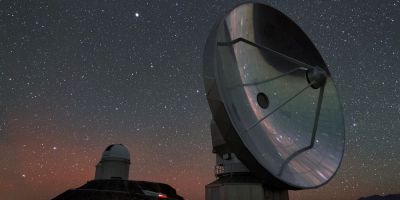 Photo: ESO
Photo: ESOThe first-ever image of a black hole in 2019 can only be captured using a global network of telescopes, the Event Horizon Telescope (EHT). To improve future measurements and make a movie about black holes, a radio telescope needs to be added in Africa. Thanks to a guarantee from Radboud University, there is now the green light to start the Africa Millimeter Telescope (AMT). The project aims to build a radio telescope in Namibia. In addition, Radboud University ensures a scientific and technical contribution to the EHT Consortium over the next 10 years.
Africa Millimeter Telescope
AMT will be Africa’s first radio telescope sensitive to millimeter wavelength radiation, and is part of a major collaboration project between Radboud University and the University of Namibia (UNAM). The main objective of the project is to expand the telescope network of the Event Horizon Telescope with a radio telescope in Namibia. Adding AMT to the EHT network allows for more communications between telescopes, allowing for better images and videos of our galaxy’s black hole. This will allow us to better test our theories of black holes, and understand how they can generate huge amounts of energy,” said Hino Falk, the project’s creator and scientific lead.
AMT also operates as an independent telescope, the only one of its kind in all of Africa. The telescope can observe differences in the brightness of large and small black holes, as well as in conjunction with optical or gamma-ray telescopes such as HESS in Namibia and CTA in Chile. The telescope, with a diameter of 15 meters, will be built according to a proven design, and will be equipped with the latest generation of instruments. Similar telescopes are already located at the European Southern Observatory (ESO) in Chile and at the Millimétrique Radio Astronomy Institute (IRAM) on the De Bury Plateau in the French Alps. AMT is operated in a sustainable manner, through the use of solar energy and possibly hydrogen.
guarantee
Radboud University guarantees $1 million annually for the management and use of the telescope and participation in the Event Horizon Telescope. This guarantee is valid for ten years and granted in phases, based on project progress and acquisition of external funds and resources. In addition, Radboud University guarantees an investment of 1.9 million euros in the AMT telescope itself. Radboud University guarantees form a good basis for applying for further grants and investments.
Han van Keriken, President of Radboud University: “It is about attractive research that can only be undertaken with significant investment and long-term international collaboration. Researchers from Radboud University can continue to contribute to this in the coming years and continue to play a leading role.”
Namibia
The University of Namibia (UNAM), along with local companies, is jointly responsible for the realization and management of the telescope. This provides unique opportunities for astronomers in Namibia to conduct their own research and advance their position in science. To prepare the next generation of Namibians for AMT, the project has its own education and awareness program and there is active collaboration with partners from the local industry. For example, the first PhD student from Namibia will begin the AMT Fellowship Program in January 2022 and the Mobile Planetarium will move to primary schools across Namibia from summer 2022.
Vice President of the University Kenneth Mattingo: “In many African societies, space has a symbolic meaning. AMT serves as a light home project for the next generation of Namibian engineers and scientists in general. In particular, it gives UNAM a unique opportunity to be part of forward-thinking, international projects that can take science To higher heights. I look forward to exciting times.” The Radboud Radio Laboratory is implementing the technical aspects of the project. Director Mark Klein Walt: “With this special support from Radboud University, the realization of the AMT telescope is becoming a reality in 5 years from now. AMT is one of the highest sciences in Namibia, together with Namibia. We are very grateful for the good cooperation with this country.”
International cooperation
The AMT project is an example of international cooperation: as early as 2015, partners such as the Rössing Foundation, Walvis Bay Corridor Group and KLM signed a statement of support. AMT’s research program is being prepared by scientists from Radboud University, University of Amsterdam, MIT, ESO, University of Oxford, University of Turku, Aalto University, VLBI-Eric Joint Institute (JIVE), and UNAM, among others. Participation in the project is also negotiated with other parties. Within the EHT, Radboud University already collaborates with European stakeholders such as Max Planck Gesellschaft, Goethe Universität Frankfurt and Institut de Radioastronomie Millimétrique.
Huib Jan van Langevelde, Director of EHT (JIVE Dwingeloo/Leiden University), is enthusiastic about the award and supports the importance of Radboud University’s guarantee for the AMT project: “AMT is an essential extension of the global network, and an important step forward in advancing future science using the Event Horizon Telescope” .
Source: Radboud University

“Thinker. Coffeeaholic. Award-winning gamer. Web trailblazer. Pop culture scholar. Beer guru. Food specialist.”







More Stories
Comet Tsuchinshan-Atlas is ready to shine this fall
Sonos isn’t bringing back its old app after all
Indiana Jones and the Great Circle is coming to PS5 in spring 2025